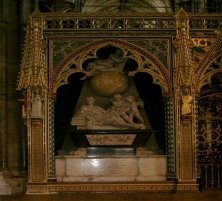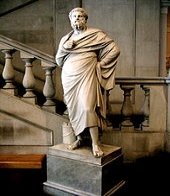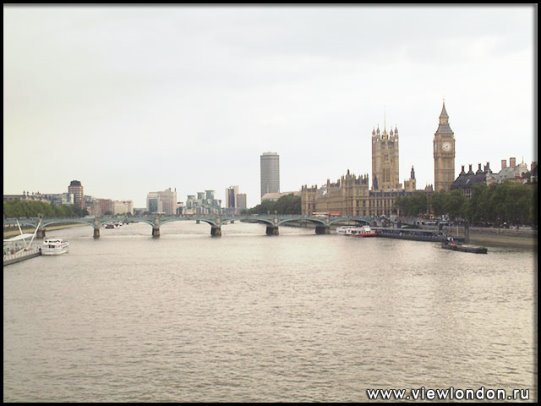Лондон в літературі. Лондон Дена Брауна
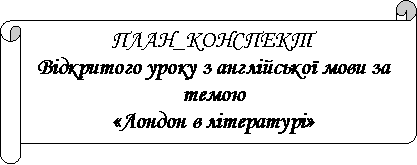

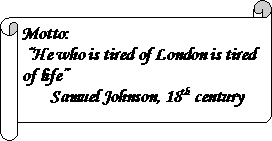

Тема: «Лондон в літературі. Лондон Дена Брауна»
Мета: Використання набутих знань з англійської мови в ситуаціях реального спілкування;
Розвиток комунікативних здібностей учнів;
Підвищення інтересу учнів до культурних реалій Великобританії.
Обладнання: Посібник «Англійська мова»,
карта-схема Лондону,
Ден Браун, роман «Код Да Вінчі»,
фотографії місць в Лондоні, пов’язаних з романом «Код Да Вінчі» Дена Брауна,
«Ілюстрований путівник для читаючих «Код Да Вінчі»,
інтерактивна дошка.
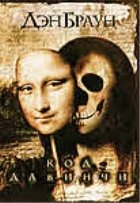
![[]](/uploads/files/894382/169828/182468_html/images/169828.006.jpg)
Хід уроку:
Teacher: Good Afternoon, children. I’m glad to see you are ready for the lesson. Today we’ll continue speaking about the ways of spending our free time on travelling. At our last lesson we‘ve spoken about climbing the Everest. It was a kind of rather extreme tourism. The topic of this lesson is travelling around the big city. What was your home task?
Pupil: To read and translate the text about London and to find some additional information about it.
Teacher: Thank you. \today we are going to speak about London. Now look at the blackboard. You see the motto. These words were said by a famous Englishman Samuel Johnson in the 18th centurу. But they are still correct. One can never get tired of London as it is so great and full of attractions that even a Londoner can always find something new and interesting about this city. Just step aside from your usual route and immediately you will be caught by one of its wonders. Do you agree with this statement? OK. Now we’ll try to prove it.
At your last lesson of maritime English you’ve written a plan for describing a city. Recollect it, please. How can you characterize London? (People name some points, e.g. port, museums, parks, theatres, shopping centre and so on).
Let’s do it in such a way. You will choose a point for description and give your reasons. E.G. London is a great educational centre as there is a world famous university there.
You’ll be given some time to do this task in pairs. Then one of you’ll have to represent your information. So, let’s listen. Who is ready? Please, be attentive not to miss the information. And don’t repeat the same things, please.
Pupil: London is a big sea port due to its geographical position. During a long period the easiest way to England from the continent was up the Thames. Though there is a certain distance between the sea and the city, large vessels can reach London because the Thames is the deepest river in the UK. One can see a great number of ships enter and leave the port of London every day.
Pupil: It’s also can be named an industrial centre as London has large shipbuilding and ship repаring yards. The dockland area is concentrated in the East End. In 1960s London docks were reconstructed and now there are all the modern facilities there. Besides there are highly-developed woolen, food and light industries.
Pupil: London is a paradise for shoppers. The best shops line up the richest streets of the West End: Regent Street, Oxford street and Bond Street. The famous department store “Harrods” in Knights Bridge is the official shop of the Royal Family. I’ve read that the owner of it Doddy la Fayet keeps here the wedding rings of his son and Princess Diana. I wonder if it’s true.
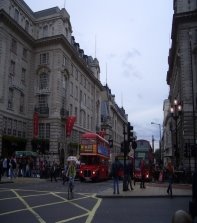


Regent Street “Harrods” Oxford street
|
|
Pupil: Theatre-lovers can also find where to go. Large number of London well-known theatres include the rebuilt in 1987 “Globe Theatre”, the copy of W. Shakespeare’s theatre on the left bank of the Thames. The immortal plays of this immortal playwright are performed there and they still enjoy wide popularity among the audience.
|
“Globe Theatre”
Pupil: Those who love horrors are able to visit London Dungeon in the East End. The Dome which was built in 1999 to mark the Millennium of the new era, is a great temptation for children and adults too. Another very popular place is the huge London Eye from which there is a splendid view of the city.
|
|
Pupil : London contains a great number of parks. They make a true oasis in the overcrowded city. Hyde Park, Regent’s Park, St. James’s Park, Kensington Gardens are beautiful in any season and please the eyes with their trees, bushes, flowers and ponds. Each park has its own peculiarity. Hyde Park has a special place called Orators’ Corner. Anyone can deliver a speech there.
|
Kensington Gardens
Options: the teacher (or other pupils) can ask each pupil questions on his/her topic, e.g. Is there a lake in Hyde park? How is the “Harrods” connected with the Queen? Are there any other theatres in London? What sights can be found in Westminster? Why is the year of 1066 known for every Englishman? And so on.).
Teacher: That’s all true. But I see you’ve forgotten a very important point. What point wasn’t mentioned?
Pupil: London is a literary city. What does it mean?
Teacher: We can say that London is a literary city not only because many great poets and writers lived and worked there but also due to the fact that many of them include London in their works as one of the main characters. E.G. John Goldsworthy with his “Forsytes’ Saga”. Can you add somebody else? Work in groups of four, please. Name only the title of the book and let your classmates to guess the author.
Pupil: “The Picture of Dorian Gray” ( Oscar Wilde)
Pupil: “The Notes of Pickwick’s Club” (Charles Dickens)
Pupil: “Harry Potter” novels (Joanne Rolling). Famous platform 9 ¾ is placed by the writer in one of London railway stations.
|
|
Pupil: I recollect “The Adventures of Sherlock Holmes and Dr. Watson” (Arthur Conan Doyle).The famous detective and his devoted friend made their investigations and caught thieves, robbers and burglars in the streets of London. In 221 Baker Street there is a museum of the best detective of all the times. |
221 Baker Street
Pupil: I’d like to complete your list with “Da Vinci Code” by Dan Broun. London acts in this novel as a real star.
Teacher: In what work do you prefer to look at London in details?
Pupil. “Da Vinci Code”.
Teacher:. Some of you have read the book, the others have seen the film. Perhaps some of you did both. Let’ recollect the plot.
Pupil. I know that the main heroes Robert Langdon and Sophie were investigating the mystery of St. Graal and the Knights of Temple. In search of the solution they arrived in London. According to the cues they visited some places there.
Teacher. I invite you to follow Robert and Sophie. I’ll read a passage of the book. (The general view of London appears on the board).
|
|
“In the distance through the mist London was arising its towers and spires. The tops of the highest buildings were glimmering in the first rays of the morning sun.” London appeared in this way in front of our heroes’ eyes. In this map you can see the beginning of their route about London. |
The general view of London
(The map appears on the board).
![[]](/uploads/files/894382/169828/182468_html/images/169828.014.png)
It’s Inner-Temple Lane. (The photo of it).
![[]](/uploads/files/894382/169828/182468_html/images/169828.015.jpg) Inner-Temple Lane
Inner-Temple Lane
Here you see the photos of some places they’ve visited in London. (The photos of the Temple Church, King’s College Library, Westminster Abbey appear on the board).
Temple Church Westminster Abbey King’s College Library
Those who have guessed, please, keep silence. For others there are some prompts. The first prompt you see on the board (words which are connected with one of the places appear on the board. For the Temple Church:
![]() ,
,  ,
,  ,
,
 ,
,  ,
,  ;
;
for Westminster Abbey:
![]() ,
,  ,
,  ,
, ![]() ,
,  ;
;
for the King’s College Library:
 ,
,  ,
,  ,
, ![]() ,
,  ,
, ![]()
Look at these words and say what place they are connected with. Work in groups.(Each group works with one portion of words).
Don’t name them aloud. Write the name in your exercise-books. Now I see all are ready. We want to hear your version. (Pupils say the names of the places).
Now we’ll vote for every version. The majority has chosen some version.
To check your answers look at the photos again and read the texts. These texts are the second prompt. You will do this task in three groups. Each group has different text.
(Pupils read the text, try to define the place)
TEXT 1
It’s one of the oldest stone churches in London. It looks more like a fortress. This building was constructed in the XII century by the Temples knights. It consists of two parts: a round church and detached square building which was erected half a century later. The basis of the round church is similar to that of the Jerusalem’s church.
Inside you can see marble columns surrounding the central part. On the floor in the middle of it monuments to 9 great knights are installed as many of famous members of the Temple Order were buried there. And here they lay armed and silent.
It was an important place for meetings of the Temple knights at the presence of the Great Magister of the Order.
In 1240 this place was a temporary residence of the Pope’s representatives, kings and churchmen from all over the world. Besides it operated as a reliable bank.
After 1307 when the Temple Order was abolished it became the Royal property.
Robert and Sophie were investigating the monuments there.
TEXT 2
It’s the third oldest university in England. The motto of this educational establishment is “With Holiness and Wisdom.” It was founded by King George 1V in 1829. The aim of its foundation was to educate “the youth of middling rich people between the ages of 15 or 16 and 20 or later.”
Chemistry, English literature and Commerce were among the subjects offered.
Its professors played a part in scientific and social advances of the 19th century through extending higher education to women, the working class and by offering evening classes.
Now it’s one of the largest centres for graduate and post-graduate medical teaching and biomedical research in Europe. There are over 18600 full-time students in it. Among the graduates of it there are 10 current Nobel Prize winners.
Academic year lasts from the last Monday in September to the first Friday in June.
The library facilities are spread across its five campuses. The collections contain over 1 mln printed books as well as thousands of journals and electronic recourses. Department of Theology’s library was visited by Robert and Sophie.
TEXT 3
The official name of this construction is the Collegian Church of St. Peter at Westminster. It is one of the oldest and the most beautiful churches in England. It was built around 1045-1050 by the king Eduard the Confessor as a part of his palace. And he was the first king who was buried there.
Later it became the coronation site of Norman kings, but none of them were buried there until Henry III. After William the Conqueror nearly all kings and queens were crowned, married and buried in this place. Many great Englishmen lay buried there. In the Poet’s Corner a lot of famous poets and writers were buried or memorialized, among them Geoffrey Chauser, Robert Burns, Lord Byron, Charles Dickens, Rudyard Kipling and many others. The tombs of great scientists such as Isaak Newton, Charles Darvin are there too. So it became one of Britain’s most significant honours to be buried or commemorated in this honorable place.
Among the treasures of this place one can see the wooden Coronation throne made in 1300.
Robert and Sophie were looking for the monument to I. Newton and the tomb of A. Pope.
Teacher: Are you ready? Have you recognized the place? If you have, don’t name it. Read the text to your classmates ant let them find out the place.
( One of the group reads the text aloud. Pupils from other groups listen and name the place).
Teacher. Now match the place with the photos. Come to the blackboard and label them.
(Pupils come out and write the names under the photos).
Teacher: Here you see some more pictures.
They show the inside interior of the Temple Church, Westminster Abbey and the King’s College Library. Match them with the labeled photos. If you were attentive enough while reading the texts, you will do it easily.
(Pupils place the pictures on the blackboard).
Teacher. The texts were presented to you in the correct order. Look at them and say what was visited first, second and third. Now describe the route in your exercise-books. Use sequencing words such as first, then, after that, later, at last, finally, next. Mind verb tenses.(Pupils write in their exercise-books, then read their sentences to the class. Others listen, complete).
Teacher. Now imagine that you are journalists and you are going to take an interview about these places. Make up a question you want to ask and be ready to answer your partner’s question. Use the following phrases: It’s interesting to know, I wonder, I think so, As for me and so on. Work in the chain. (Pupils write their questions in their exercise-books, the ask them and answer.)
Question 1. I know that one of the parks was mentioned in the novel. What park is it?
Answer: I don’t know exactly but I think it’s St. James’s Park.
Question 2. Why did they visit the library of King’s College?
Answer: Because it has the most up-to-date facilities for finding information.
Question 3. How many monuments are there in the Temple Church?
Answer: There are nine of them and one tomb.
Question 4 What was the reason for Robert to visit London?
Answer: Because there are many places connected with Temple knights.
Question 5. And I wonder what in Westminster Abbey deals with them?
Answer: Sir Isaak Newton is considered to be one of the Great Magisters.
Question 6. Why were they looking for relics of Temple in King’s College?
Answer: Its library has got the most of the available information on the topic.
Question 7. Why did Sophie take part in this rather dangerous investigation?
Answer: As all people she wanted to find out the truth.
Question 8.Why is the Temple Church so famous? Is it only because of its connection with the temple knights?
Answer: Not only because this fact. Also due to its shape. It’s one of the eight round churches which remained in England.
Question 9. It’s interesting to know where the heroes left for after London?
Answer: It seems to me they went to Scotland, to Rosslyn Chapel.
Question 10. How did Robert and Sophie get to London?
Answer: They used a plane.
Teacher. With the heroes of the book you’ve strolled along the streets of London, called at world-famous places such as Temple Church, King’s College library, Westminster. Have you gained more information about London and its attractions? Are you pleased with this virtual journey? The heroes of what book would you like to follow in London either? All of you made a valuable contribution to our lesson and worked perfectly. I think that you’ve learned London better now. (The teacher tells the marks).
Option: Teacher: While preparing for this lesson I’ve made some personal discoveries. I’ve found out that one of the rooms in King’s College library was shown as Professor Dumbledore’s office.
Teacher Maybe you will also find something amazing while doing your home task for your next lesson. In your Student’s Book you’ll do ex.1 on p. 104.You’ll use the questions of this exercise to write about your imaginary round-the -world yacht race. Besides you will learn the words from ex.4 p 104. I hope our next lesson is going to be very interesting too as we’ll speak about travelling overseas.


про публікацію авторської розробки
Додати розробку
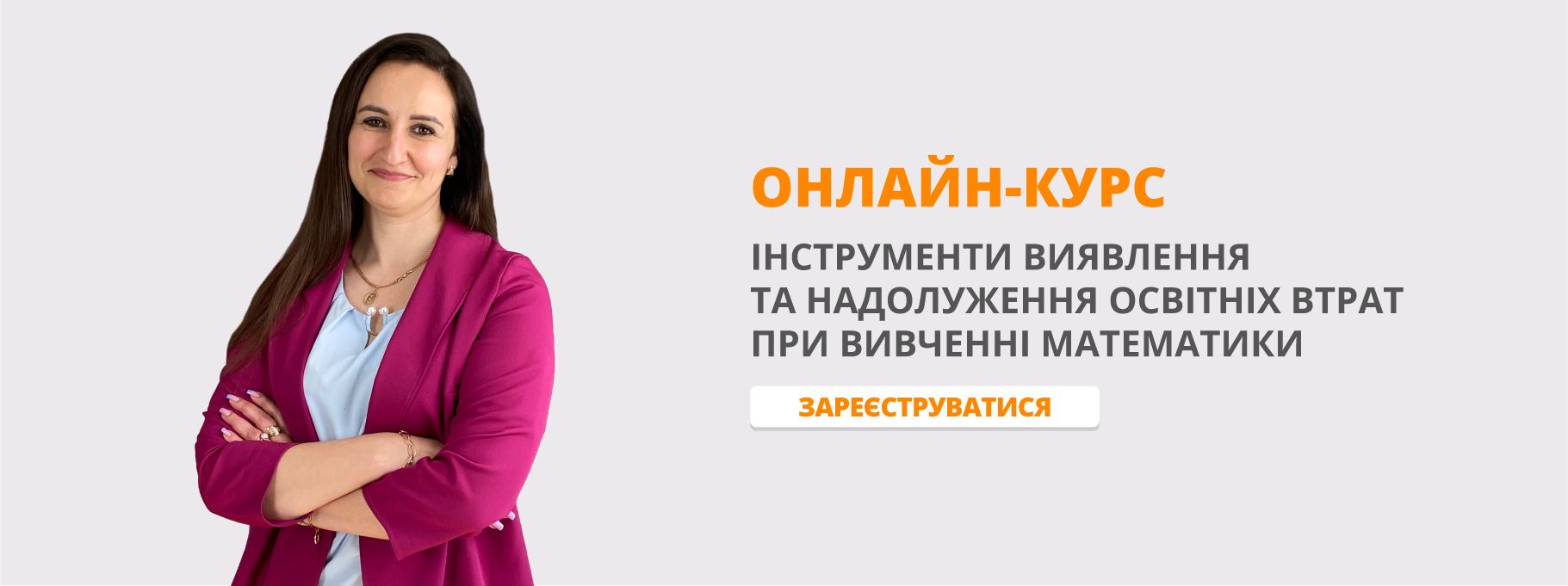
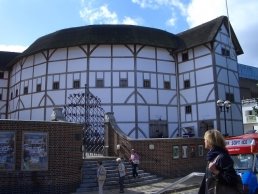
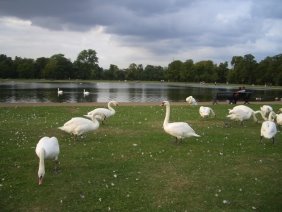
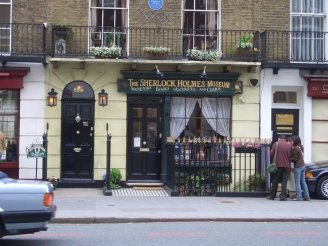
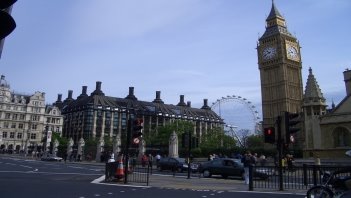
![[]](/uploads/files/894382/169828/182468_html/images/169828.016.jpg)
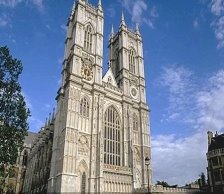

![[]](/uploads/files/894382/169828/182468_html/images/169828.036.jpg)
